|
|
|
ADVERTISEMENTS
|
|
PREMIUM
- HAPPY HOLIDAYS!
- Siliconeer Mobile App - Download Now
- Siliconeer - Multimedia Magazine - email-Subscription
- Avex Funding: Home Loans
- Comcast Xfinity Triple Play Voice - Internet - TV
- AKSHAY PATRA - Bay Area Event - Sat. Dec 6
- Calcoast Mortgage - Home Loans
- New Homes in Silicon Valley: City Ventures - Loden Place - Morgan Hill
- Bombay to Goa Restaurant, Sunnyvale
- Buying, Sellling Real Estate in Fremont, SF Bay Area, CA - Happy Living 4U - Realtor Ashok K. Gupta & Vijay Shah
- Sunnyvale Hindu Temple: December Events
- ARYA Global Cuisine, Cupertino - New Year's Eve Party - Belly Dancing and more
- Bhindi Jewellers - ROLEX
- Dadi Pariwar USA Foundation - Chappan Bhog - Sunnyvale Temple - Nov 16, 2014 - 1 PM
- India Chaat Cuisine, Sunnyvale
- Matrix Insurance Agency: Obamacare - New Healthcare Insurance Policies, Visitors Insurance and more
- New India Bazar: Groceries: Special Sale
- The Chugh Firm - Attorneys and CPAs
- California Temple Schedules
- Christ Church of India - Mela - Bharath to the Bay
- Taste of India - Fremont
- MILAN Indian Cuisine & Milan Sweet Center, Milpitas
- Shiva's Restaurant, Mountain View
- Indian Holiday Options: Vacation in India
- Sakoon Restaurant, Mountain View
- Bombay Garden Restaurants, SF Bay Area
- Law Offices of Mahesh Bajoria - Labor Law
- Sri Venkatesh Bhavan - Pleasanton - South Indian Food
- Alam Accountancy Corporation - Business & Tax Services
- Chaat Paradise, Mountain View & Fremont
- Chaat House, Fremont & Sunnyvale
- Balaji Temple - December Events
- God's Love
- Kids Castle, Newark Fremont: NEW COUPONS
- Pani Puri Company, Santa Clara
- Pandit Parashar (Astrologer)
- Acharya Krishna Kumar Pandey
- Astrologer Mahendra Swamy
- Raj Palace, San Jose: Six Dollars - 10 Samosas
CLASSIFIEDS
MULTIMEDIA VIDEO
|
|
|
|
|
NEWS DIARY | AUGUST
India Monsoon Worst in 40 Years | Climate Change Threatens Nepal Villagers | Swine Flu Toll 83 | New Taliban Chief | High Growth Target | Lanka Denial | MiG Intercepts Plane | Judges’ Assets
India Monsoon Worst in 40 Years
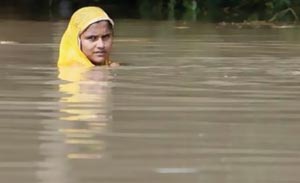 A flood-affected woman waits for relief supplies at Koran Tola village of Malda district in West Bengal. A flood-affected woman waits for relief supplies at Koran Tola village of Malda district in West Bengal.
India’s monsoon rains may improve next month but are still set to be the worst in four decades, and the associated slow filling of reservoirs is putting winter crops and power supplies at risk.
Monsoon rains, the lifeline for farms that support more that half of India’s 1.1 billion people, have been patchy this year and about 40 percent of India’s districts are drought-hit.
The head of the weather office, Ajay Tyagi, said September rainfall would improve, but the four-month season since June would still be about 20 percent below normal.
That would make it the worst since 1972 when there was also a severe El Nino phenomenon, in which changes in sea temperature in the Pacific Ocean affects weather.
Low rains have ravaged India’s rice crop and hit soybean, cane and groundnut, and disrupted the flow of water into the main reservoirs that are vital for hydropower generation and winter irrigation.
Water levels in India’s main reservoirs rose to 42 percent of capacity on Aug. 27, government data showed, rising 3 percentage points in a week. The rise is smaller than a 10-year average of a rise of 5 percentage points for the week.
“Water storage in reservoirs is a very good regionalized and robust indicator of realistic rainfall in the vast catchment,” the farm ministry says.
Reservoirs are important for hydropower, which accounts for a quarter of India’s generation capacity of about 150,000 megawatts. They also provide water to irrigate winter crops.
A 19 percent rain deficit in 2002 reduced India’s summer-sown harvest by 22 percent and the output of winter-sown crops by 13 percent.
This year, the cane crop in India’s top producing state of Uttar Pradesh is expected to shrink about 16 percent because of drought.
|TOP|
Climate Change Threatens Nepal Villagers
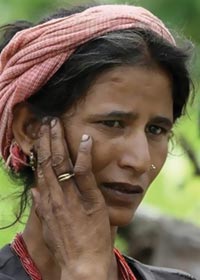 Nepalese villager Naina Shahi in the village of Bhattegaun. Nepalese villager Naina Shahi in the village of Bhattegaun.
Three years ago Naina Shahi’s husband left their small village in rural Nepal to seek work in India, leaving her to bring up their three children alone.
The dry winters and unpredictable monsoons Nepal has experienced in recent years had hit crop production on the couple’s land plot in the foothills of the Himalayas, forcing them to look for other ways to feed their family.
For the past two years, their crop has failed entirely and Shahi now buys rice on credit from a local shopkeeper while she waits for her husband to return to their village with his earnings.
“My husband stopped farming because this place is not good for growing crops. We needed to earn money to feed the children,” Shahi, 35, told AFP in the remote village of Bhattegaun in mid-western Nepal.
“There is not enough rainfall for the crops to grow well and we have to walk for two or three hours every day to get water.”
International aid agency Oxfam says Nepal’s changing weather patterns are threatening the livelihoods of hundreds of desperately poor communities already struggling to produce enough food to survive.
In a new report released 100 days before a conference in Copenhagen aimed at sealing an international accord on fighting climate change, Oxfam warns of the potentially devastating effects on people in the Himalayan nation.
“The majority of Nepal’s population are poor farmers reliant on rainfall and occupying small parcels of land that can barely produce enough food for the family,” it said.
“They often live in areas most at risk to floods and landslides and are more reliant on local natural resources such as forests and water.
“Even small changes to rainfall patterns can have devastating consequences on their crops,” said the report, based on interviews conducted in rural communities across Nepal in February and March this year.
|TOP|
Swine Flu Toll 83
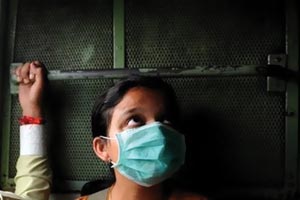 An Indian girl wears a protective mask as she travels on a local train in Mumbai. An Indian girl wears a protective mask as she travels on a local train in Mumbai.
Five more swine flu deaths were reported Aug. 28 in India, taking the toll from the H1N1 virus to 83, health officials said.
Three patients died in Karnataka and one each in Maharashtra and Kerala. In Karnataka, two deaths were reported from Bangalore and one from Bijapur.
According to Maharashtra health authorities, a 39-year-old man suffering from swine flu died at a Navi Mumbai hospital. With this, the toll from the viral disease in the state has risen to 48.
The victim, identified only as Shaikh by State Swine Flu Control Room head Pradip Awate, was admitted to DY Hospital in Navi Mumbai a few days ago in a serious condition and died late Aug. 27.
He was Mumbai’s 10th swine flu victim, Awate said.
In addition, there have been 25 deaths in Pune, seven in Nashik, two in Latur and one each in Aurangabad, Beed, Jalna and Dhule.
According to officials, Maharashtra has recorded the highest number of deaths and H1N1 cases in the country. A staggering 1,519 cases have been reported from the state.
So far, 22 of the 34 districts in the state are swine flu-affected, the worst hit among them being Pune, Mumbai and Nashik.
Karnataka has reported the second highest deaths after Maharashtra at 23.
The swine flu scare led to the closure of the Bangalore-based National Law School of India University for 10 days. The decision follows several educational institutions closing down for a few days.
“The decision was taken as a precautionary measure. The university decided to close for 10 days, so that the entire campus can be fumigated. The fumigation process has already started,” NLSIU Vice Chancellor R. Venkata Rao said.
|TOP|
New Taliban Chief
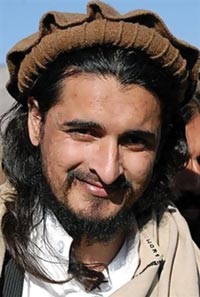 Hakimullah Mehsud Hakimullah Mehsud
The Taliban has ravaged Pakistan, but its leadership is in tatters, reports Time magazine. After weeks of denials, two Pakistani Taliban commanders admitted on Aug. 25 that the group’s chief, Baitullah Mehsud, had been killed in an Aug. 5 U.S. missile strike. The commanders also confirmed reports that Hakimullah Mehsud, a regional chieftain close to Baitullah and one of the organization’s rising stars, had been tapped to take the top job.
The announcement highlighted the degree to which the Taliban has been decimated by infighting and drone attacks — as well as the degree to which keeping tabs on a group shrouded in secrecy remains a formidable challenge. Pakistani officials had recently issued conflicting reports as to whether Hakimullah was even alive; intelligence sources suggested he had been killed in a shootout during a Taliban meeting convened to decide on Baitullah’s successor. Some still suspect that the man calling himself Hakimullah is, in fact, an imposter claiming to be the terror chief in a bid to convince the world that the group’s fractious leadership remained intact. Assuming he’s alive, though, relatively little is known about the ascendant young leader, who is a member of the same tribe as his predecessor Baitullah but is not thought to be a close relative. Still, reports suggest that Pakistan and its ally the U.S. may have rid themselves of one problem only to gain another.
|TOP|
High Growth Target
Bangladesh has targeted export earnings of $17.6 billion for the current fiscal year, a growth of 13 percent despite the continuing global downturn, a senior official said.
“This is our projection and it is achievable if everything goes well,” said Mohammad Shahab Ullah, vice chairman of the government’s Export Promotion Bureau.
Bangladesh’s exports grew 10.3 percent to $15.56 billion in the 2008/09 fiscal year, the lowest growth in six years, reflecting falling demand as a result of the global economic slump.
The target for the current fiscal year, which ends next June 13, was set by the EPB after talking with exporters of ready-made garments which account for more than 80 percent of the country’s shipment.
“They have agreed with our upward projection,” Shahab, the chief executive of the EPB told Reuters.
Bangladesh’s ready-made garment exports have done well in the outgoing fiscal year due to a very competitive prices.
“We expect at least a growth similar to previous year from the sector in 2009/10, and I believe the global recession will not be a major hindrance to textile exports,” he said.
Earnings from knit textiles in July to June of the previous fiscal year rose 16.2 percent to $6.4 billion while exports of woven garments rose 14.5 percent to $5.9 billion in the same year.
For the current fiscal year, all the major export products barring petroleum products have been projected to grow, including the top item knitwear at 13.50 percent, woven garments 13 percent, leather 30 percent, medicines 15 percent and agro-processed food 76.66 percent.
Export of frozen food is expected to grow a modest three percent.
|TOP|
Lanka Denial
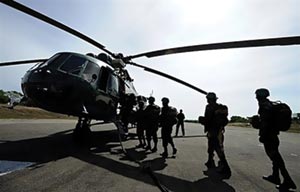 Sri Lankan army commandos board a helicopter for a media display of their skills. Sri Lankan army commandos board a helicopter for a media display of their skills.
The Sri Lankan High Commission in London has denied that its army was involved in atrocities against the ethnic Tamil minority after British television aired a video allegedly showing a soldier executing two men.
Channel 4 News showed disturbing footage of a man dressed in army uniform shooting a naked, bound and blindfolded man in the back of the head, while the bodies of several other men were seen nearby in a muddy field.
Another man was also shot in the same way towards the end of the video.
In its report, Channel 4 stressed it could not verify the authenticity of the video which it received from a group called Journalists for Democracy in Sri Lanka.
The group claims the video footage was taken in January by a soldier using a mobile phone.
Sri Lanka’s office in London said soldiers were only involved in fighting against Liberation Tigers of Tamil Eelam rebels.
“The High Commission of Sri Lanka categorically deny that the Sri Lankan armed forces engaged in atrocities against the Sri Lankan Tamil community,” it said in a statement to Channel 4.
“They were only engaged in a military offensive against the LTTE.”
“The High Commission has noted that in many instances in the past, various media institutions used doctored videos, photographs and documents to defame the Sri Lankan government and armed forces,” it added.
The United Nations has estimated that between 80,000 and 100,000 people have been killed in Sri Lanka’s drawn out Tamil separatist conflict which the security forces declared ended in May.
|TOP|
MiG Intercepts Plane
India scrambled a MiG-29 fighter jet to intercept an Air France passenger plane after it failed to identify itself correctly, the Indian Air Force says.
The Bangkok-bound flight from Paris had entered Indian airspace from Pakistan.
The pilot had used the wrong Identify Friend or Foe (IFF) code, which allows ground radars to differentiate between friendly and enemy aircraft.
The MiG was told to “break off and return to base” when the correct code was given, an air force official said.
Flight Lt Priya Joshi also told the AFP news agency that a report had been filed with India’s civil aviation authorities over the incident.
The Air France Airbus-343 had entered India above Amritsar, in the north-west of the country, early Aug. 27 morning.
The Indian Air Force has stepped up security along the border with Pakistan in the wake of the 2008 Mumbai attacks that killed more than 170 people.
|TOP|
Judges’ Assets
Judges at India’s Supreme Court have agreed to make public details about their financial assets and to publish the information on the court’s Web site.
The landmark decision follows intense public debate about the importance of judicial accountability in India.
It was taken at a meeting between the 23 judges of the country’s highest court and presided over by Chief Justice K.G. Balakrishnan.
The decision is likely to lead some 600 high court judges to follow suit.
The decision comes days after Chief Justice K.G. Balakrishnan said that the judges needed to arrive at a consensus on public declaration of their assets in the absence of a law.
It also follows a recent statement by two high court judges that they would publicly disclose their assets.
One of them, Justice Shylendra Kumar of the high court in the southern Karnataka state, has already handed a list of his assets to the court authorities for publication on a Web site.
A number of retired judges have welcomed the decision.
“I am extremely happy that by taking this step, it will mean an end to the unsavory debate engulfing the judiciary,” former Chief Justice J.S. Verma said.
The Indian media echoed the sentiment.
“The opposition within sections of the higher judiciary to mandatory public disclosure of judges’ assets — a measure to promote judicial transparency and check judicial corruption — threatened to weaken public confidence in the judicial system,” The Hindu newspaper wrote.
There has been rising public demand for greater transparency on the part of judges after allegations of corruptions against some judges over the last few years.
Earlier this month, the government was forced to delay the introduction of a bill in parliament that exempts judges from making their income and assets public after criticism from opposition parties.
|TOP|
|
|
|
|
|
|